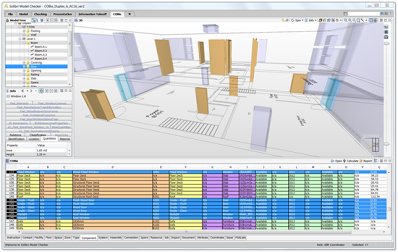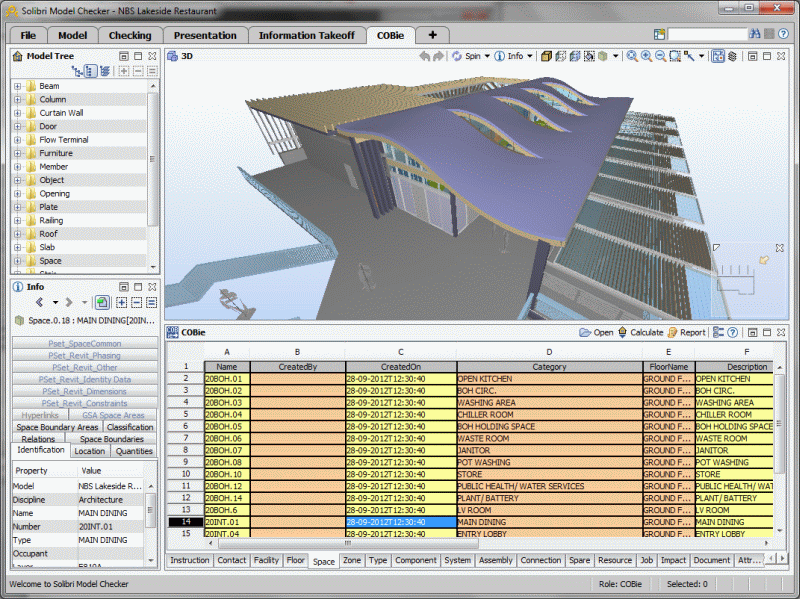The specification, a real challenge for the manufacturer.
The further upstream the specification is performed and locked, the more the manufacturer gains visibility and an idea of its volume and can monitor the project as closely as possible. Hence the reason it is important for a manufacturer to provide objects with data.
Here we will analyse the functioning of the COBie document which makes allows information about objects and / or projects to be provided. Then we will examine the results of a study of specifiers that explains their reasons for how and what they specify.
To begin with, COBie stands for “Construction Operation Building information exchange”, which is a non-patented data format for the publication of families in the digital model, focused on the benefits of data provided separately from geometric information. This data exchange format is the standard defined in the UK market.
In a classic construction project
The information about the building is contained in the plans, the invoice figures and in the special technical specifications. The construction specialists work together to gather this documentation. This must then be updated throughout the construction phase and delivered to the customer.
The objective behind this format is to obtain key information in this format and then share it with the construction team during the defined project phases.
The COBie document is an excel spreadsheet with several tabs.

The « COBie » tab is not by definition a complete BIM template, but contains content structured by all members of the construction team and all information models as shown in the screenshot below. This information can be extracted from a CAD model.
The « Type » tab lists the information extracted from the product lists defined for the building, their references and the manufacturer’s information. The “Attribute” tab details the properties of each type of object, and all the standards to which it must conform. The “Components” tab presents all the possible cases for this product. The information from this object comes initially from the CAD model and is then linked to the type of information from the special technical specifications.
The « Contact » tab lists the details, information and the missions of the company. It is a complete list of contacts from design consultants to the construction team, including the manufacturers and suppliers of the systems and products. This information comes from the preliminary document and the special technical specifications.
The « Job » tab allows specific Facility Management tasks to be assigned to all the various objects that make up the building. The excel table makes it possible to link the data. The occurrences of a window, for example, may be related to the technical characteristics of the window type via a simple drop-down list. Similarly, when a Facility Management task is assigned, it can be assigned to the most relevant component.
COBie can be used to populate a product’s data and to support the specification / selection / replacement process. There are currently 700 so-called COBie format templates available; HTML, XHTML, IFC and IFCXML.
NBS survey, the responses received are impressive
Closed in early December 2016, this survey shows us that 65% of respondents agree that in the future, specifications will have a life span the same as the building to which they are attached.
More than half of the specifiers make their proposals according to product performance; less than half use manufacturers’ brands. Even if we combine price and process, this approach is the least popular.
During the briefing, 69% of the specifiers think about the products they will use in the building. More than half reuse their specifications.
To reduce product variants, more than half of the specifiers surveyed need locked specifications. Virtually the same percentage require specifications.
What is the future for specification?
More than half of the respondents seek collaboration. Almost 9 out of 10 people think that specification has a future in the digital world, more than half think that specification will have to comply with European standards, while 60% see specification as being a complete part of the BIM model.
75% of specifiers surveyed believe that specifications will become even more central, and more than ¾ of them also expect specifications to be digitally linked to both 2D and 3D plans – this is at the heart of BIM.
How is product information obtained?
The majority of specifiers find information on the internet. References from paper documents still have an important place. 80% of respondents find it quicker to refer to the technical summary before doing detailed research.
Finally, most rely on their experience of products and manufacturers to choose a product. They also indicate that BIM already influences decisions.
The majority of specifiers use search engines such as Google to select a product, or go to the manufacturer’s website. The technical description and information of a product manufacturer is important for specifiers.
It is therefore observed that the information associated with an object is crucial for the manufacturers and directly related to the specification during the design phase. The completion of this information facilitates the specification for the design team if it is done correctly.
There are solutions to automatically and online link the technical characteristics of a product manufacturer to a document. This provides the possibility of writing special technical specifications more quickly by linking stored information to the geometry of the object.
